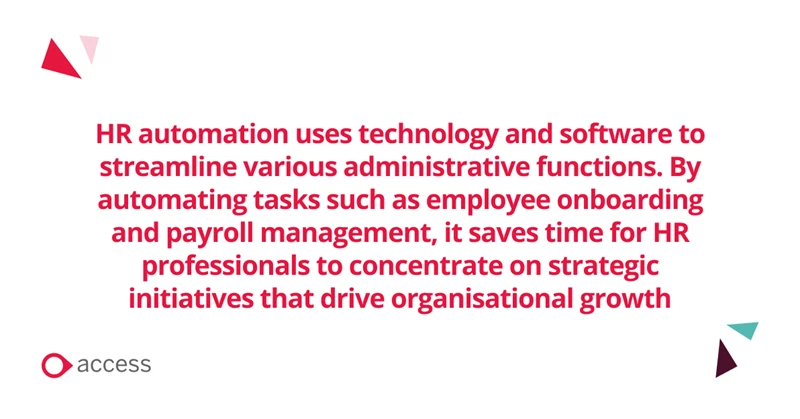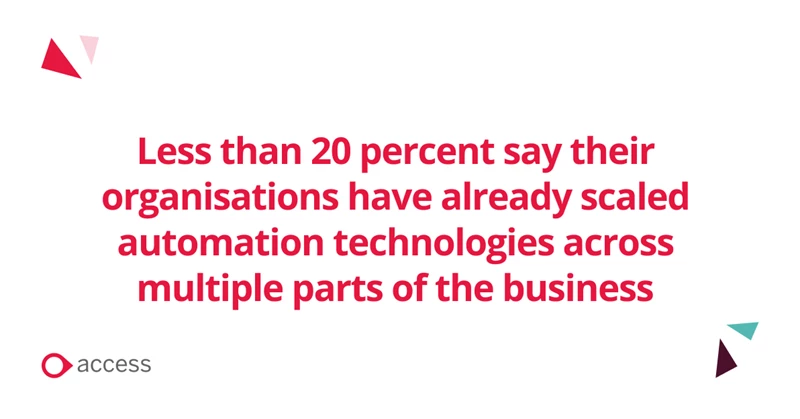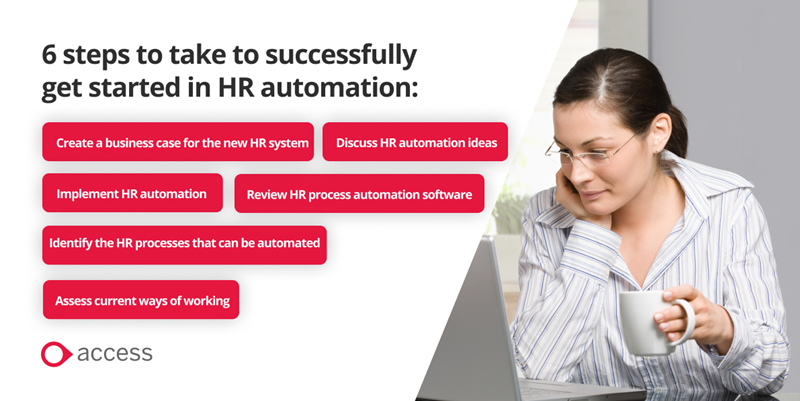-
- Employee Benefits
- Employee benefits
- Employee engagement
- Employee rewards
- Employee wellness hub
- Caboodle
-
- Your Stakeholders
- HR Director
- IT Director
- Finance Director
-
- Resources
- Guides and whitepapers
- Blogs
- Webinars
- Case studies
-
- Contact Us
- Contact Us
- Partner Programme

A guide to HR automation
If your HR department is being bogged down by manual processes that are taking away from strategic decision-making initiatives and human connection, then it is likely time to start thinking about how to automate HR processes with HR software.
HR should be so much more than a place where ‘admin’ happens. With HR process automation empowering your people and processes, you can liberate teams to do more, make work methods and practices more efficient, and free up managers’ time to help take your HCM to the next level.
So, let’s answer the question ‘what is HR automation?’, look at where it can be implemented and how the process can make a difference to your organisation as a whole.
 9 minutes
9 minutes
Written by The Access Group
What this page covers
What is HR automation?
HR automation is the process of using technology and software to help streamline tasks within a Human Resources department. The goal of HR automation is to increase productivity, save time and ultimately help to create a workforce focused on strategic tasks rather than laborious ones that aren’t adding value.
This reallocation of human resources toward more considered activities ultimately fosters greater efficiency and productivity. However, careful thinking is required to successfully manage the impact and cultural change that comes with it. It is also important to find the balance between helpful technology and the human connection that is crucial for HR teams to excel.

What are the benefits of automating HR processes?
By implementing automation, businesses can streamline and optimise processes that have historically been labour-intensive and often lacked substantial benefits. Below are three HR automation benefits that may help you make the decision.
1. Reduces human error
With HR teams spending a lot of their time dealing with often manual and data-heavy tasks, it is no surprise that errors can occur along the way. With HR automation, this can be drastically reduced as everything is digitised and centralised, meaning that repetitive tasks are now streamlined.
2. Streamlines recruitment processes
By smoothing out data flows and automating all-important recruitment processes, you can deliver a user journey that helps to entice and secure great people through engaging content, real-time responses and personalised communication.
3. Data-driven decisions
In this era of automated data management, there’s really no excuse for inaccurate or disjointed data files and systems. By getting into the swing of automatically regimented data collection, storage and distribution, as well as harnessing the potential of analytics, electronic information becomes a vital tool for companies and another realistic route to competitor differentiation.
HR processes that can be automated: HR automation ideas
According to McKinsey, less than 20 percent say their organisations have already scaled automation technologies across multiple parts of the business.

There are many different ways that your organisation can automate HR tasks. Everything from recruitment and onboarding to workforce planning and payroll has the potential to be revolutionised by automated technology. Below are six processes that HR automation can help with.
1. Recruitment
Attracting and keeping great new recruits gets simpler because by smoothing out data flows and automating all-important recruitment processes, you can deliver a fantastic user journey that helps to entice and secure great candidates through engaging content, real-time responses and personalised communication.
2. Employee onboarding
Engaging new starters as soon as they are through the door with a tailored experience not only helps to fast track their success, but it also provides them with the tools and information they need to hit the ground running. This could include auto-enrolment for the new starter and automatically assigning the relevant training to them so they can avoid delays.
3. Time and attendance tracking
Eliminating the manual recording of employee work hours, curbing errors and ensuring accurate payroll calculations are just some ways that automating time and attendance can help streamline workflows. It also enhances transparency by providing real-time insights into employee attendance patterns, aiding in effective workforce management and decision-making.
4. Training and development
A quality digital learning management system (or LMS), allied to modern, mobile devices, lets employees access learning content at a time and place of their choosing. It can inform team leaders about eLearning completions or any difficulties that might arise in a timely manner, ensuring that the flow of training is kept up to date.
5. Payroll processing
Automating your payroll processes reduces processing time while boosting accuracy, guarantees compliance with regulations, and enhances employee contentment by ensuring timely and error-free payments. This strategic move not only streamlines operations but also delivers cost savings and data security, reinforcing its role as a pivotal tool for modern payroll management.
6. Employee benefits
An employee benefits or rewards package can be a great way to recognise the efforts of employees, and plenty of processes can be automated. Having a dedicated benefits app which is accessible 24/7 for users to access their benefits online or instore will promote a seamless and user-friendly experience. Automation also allows for real-time tracking and reporting of benefit usage which enables HR teams to make informed decisions.
What HR automation tools should your organisation consider?
When exploring HR automation tools that may benefit your organisation, look at tasks that are not automated and how implementing these tools will help to resolve them and make the lives of your HR team easier. Below are some tools that may be offered for specific automation processes:
Recruitment
- Candidate screening
- Personalised career website/portal
- Applicant tracking system
- Recruitment reporting
Onboarding
- Bespoke dashboards
- Compliance tracking and monitoring
- Easy access to employee documents
Payroll software
- Online payslips
- Payroll reports
- GDPR reporting and automated alerts
Employee benefits
When looking at specific HR automation tools, something else to be aware of is the different options available depending on the providers. Some can offer you standalone systems which usually don’t talk to each other, whereas others have an integrated system which works intuitively as one. For HR automation purposes, the latter may be most suitable. By incorporating streamlined workflows and automated processes, integrated HR software has the capability to eliminate many conventional manual HR tasks.
Are there any disadvantages to HR automation?
As we have discussed within this article, there are many HR automation benefits that arise when you automate HR tasks. However, there are some challenges and limitations to consider when looking at how it can impact your organisation.
A point to consider is how crucial the personal touch is for HR departments. Not only are they dealing with sensitive matters on a regular basis, the HR team is usually seen as the face of the organisation (no matter the size) and there is an appreciation that comes with speaking directly to a person. There is a risk that automation can make some processes feel robotic and impersonal.
It is also worth thinking about the training that will need to be undertaken in order for staff to effectively use the automation tools. Since the purpose of HR automation is to streamline processes and save time, it is important that everyone understands how to properly utilise the tools to avoid confusion later down the line.
If you are using external automation tools, ensure that training is included within the package and that it can easily be rolled out to whoever needs it. Be aware that this may be time-consuming to begin with but will likely save time in the long run once processes are in place and training has been completed.
How to get started in HR automation: a step-by-step guide

If your organisation currently has no HR processes which are being aided by automation, or you can see further opportunities for HR process automation, then you can start the process of effectively implementing and using HR automation.
Below are 6 steps to take to successfully get started in HR automation:
1. Discuss HR automation ideas
Think about what areas within your HR processes could benefit from being automated. Look at the list we collated earlier to understand the full scope of HR automation opportunities. Create a list of ideas to then compare with your current processes.
2. Assess current ways of working
Find out where there are opportunities to automate HR tasks and improve how your HR team carries out certain tasks. Consider asking the following questions:
- What is currently working well in the HR department?
- Which could be made easier by HR process automation?
- Do you want to use an integrated or standalone HR system?
3. Identify the HR processes that can and cannot be automated
Some HR processes can benefit from automation while others require a more hands-on approach, where communication is key. Ensure at this stage that you have identified the processes that you want to automate and those that should stay as they are.
4. Review HR process automation software
Once you have made the decision to automate tasks within the HR department and what, you can begin to look at what HR automation software is most suitable for your organisation and ways of working. Compare packages, prices, and find out what suits your specific needs.
5. Create a business case for the new HR system
As with most decision-making processes within an organisation, there will likely be a need for buy-in from stakeholders, so you should consider putting together a business case for a new HR system. Ensure you have clearly expressed the benefits of automating HR processes and the role this plays in your overall HR improvement plans. State a clear case to the decision-makers on the ways in which it will help to reduce admin time and add value.
6. Implement HR automation
Once sign-off has been given, it is time to implement the HR automation processes. Ensure training of users is carried out and the roll-out is communicated with your entire organisation, so they can understand the changes that will take place.
How to automate HR processes: Final thoughts
As we have discussed within this guide, there are a huge array of HR processes that can be automated and it’s up to your organisation as to how you make the most of the options available.
By understanding how to automate HR processes and the wide range of HR automation benefits, you can unlock the full potential of your HR function and propel your organisation toward more efficient and impactful operations.
Get in touch to find out how HR software can deliver greater value for your organisation
Learn more with our HR and Payroll blogs
Our HR and payroll blogs offer advice and guidance from industry experts.



